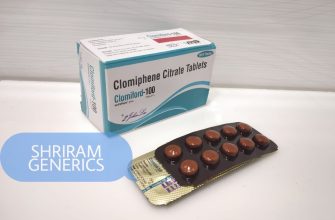Planning to purchase Clomid and HCG? You need a prescription. Both medications significantly impact hormone levels, and unsupervised use can lead to adverse health outcomes. First, schedule a visit with a reproductive endocrinologist or a qualified physician. They will conduct thorough assessments, including hormone level testing and a review of your medical history, to determine if these medications are appropriate for you.
Once you have a valid prescription, explore reputable pharmacies. Prioritize licensed pharmacies, either local or established online retailers. Verify their credentials by checking for certifications from regulatory bodies like the National Association of Boards of Pharmacy (NABP). Always be wary of websites offering these medications without a prescription, as they are often selling counterfeit or unsafe products. Compare prices, but remember that the cheapest option isn’t always the best when your health is involved. Factor in shipping costs and delivery times if ordering online, and ensure the pharmacy has secure payment processing and discreet packaging.
Before starting treatment, discuss potential side effects with your doctor. Clomid can cause hot flashes, mood swings, and blurred vision, while HCG may lead to injection site reactions and, in rare cases, ovarian hyperstimulation syndrome (OHSS). Understand the signs and symptoms that require immediate medical attention. Keep a detailed record of your medication schedule and any symptoms you experience, and maintain open communication with your healthcare provider throughout the treatment process.
- Buy Clomid and HCG: Information Guide
- Clomid (Clomiphene Citrate): How It Works
- HCG (Human Chorionic Gonadotropin): Triggering Ovulation
- Understanding Clomid and HCG
- How Clomid Works
- The Role of HCG
- Clomid and HCG: Uses and Benefits
- Potential Uses in Women
- Potential Uses in Men
- Where to Buy Clomid and HCG Safely
- Dosage and Administration Guidelines
- Potential Side Effects and Risks
- Important Considerations Before Buying
Buy Clomid and HCG: Information Guide
Consider Clomid and HCG carefully. Both medications affect hormone levels and require proper medical supervision. Discuss your medical history and fertility goals with a doctor before pursuing either treatment.
Clomid (Clomiphene Citrate): How It Works
Clomid stimulates ovulation by blocking estrogen receptors. This tricks your brain into thinking estrogen levels are low, causing it to release more follicle-stimulating hormone (FSH) and luteinizing hormone (LH). FSH stimulates the growth of ovarian follicles, each containing an egg. LH triggers ovulation, the release of a mature egg. Dosage varies, typically starting at 50mg daily for five days. Your doctor will monitor your response with blood tests or ultrasound.
HCG (Human Chorionic Gonadotropin): Triggering Ovulation
HCG mimics LH, triggering the final maturation and release of the egg from a dominant follicle. Doctors often administer HCG after Clomid treatment when monitoring indicates a mature follicle. It’s usually given as an injection. You should understand the timing of intercourse or intrauterine insemination (IUI) after HCG injection.
Possible Side Effects: Clomid side effects include hot flashes, mood swings, and blurred vision. HCG can cause ovarian hyperstimulation syndrome (OHSS), a potentially serious condition. Discuss all potential risks with your physician.
Monitor your symptoms carefully. Contact your doctor immediately if you experience severe abdominal pain, bloating, or shortness of breath. Buying Clomid and HCG requires a prescription in most countries. Do not purchase these medications from unregulated sources. Verify the legitimacy of any online pharmacy before ordering. Look for accreditation and check for a valid prescription requirement.
Pregnancy rates with Clomid vary depending on age and underlying fertility issues. Discuss realistic expectations with your doctor. HCG is generally administered under strict medical supervision due to the higher risk of OHSS.
Understanding Clomid and HCG
Clomid stimulates your body to release hormones that trigger ovulation. HCG then mimics luteinizing hormone (LH), aiding egg maturation and triggering its release. You often use them together to maximize the chances of pregnancy.
You must always consult a doctor before using Clomid or HCG. They can determine the correct dosage and monitor you for potential side effects.
How Clomid Works
Clomid tricks your brain into thinking estrogen levels are low. This prompts the pituitary gland to release follicle-stimulating hormone (FSH) and LH. FSH stimulates the growth of ovarian follicles, which contain eggs, and LH triggers ovulation.
- Take Clomid orally, starting on day 3, 4, or 5 of your menstrual cycle. Your doctor will tell you which day to begin.
- Typical Clomid dosages range from 50mg to 250mg per day.
- Expect ovulation to occur 5-10 days after your last Clomid pill.
The Role of HCG
HCG works similarly to LH. Once a follicle matures, HCG triggers the final stages of egg maturation and release from the ovary. Your doctor might prescribe it if your LH surge isn’t strong enough after Clomid.
- HCG is administered via injection.
- The timing of the HCG injection is important. Your doctor will schedule it based on follicle size monitoring via ultrasound.
- You typically administer HCG 36-48 hours before anticipated ovulation.
Discuss all medications and supplements you’re taking with your doctor. They need to know your complete medical history before prescribing Clomid or HCG to prevent adverse interactions.
Clomid and HCG: Uses and Benefits
Combine Clomid and HCG therapy to stimulate ovulation and boost testosterone levels. Clomid, a selective estrogen receptor modulator (SERM), blocks estrogen’s effects, prompting the pituitary gland to release more follicle-stimulating hormone (FSH) and luteinizing hormone (LH). This surge triggers ovulation in women and increases testosterone production in men.
Administer HCG (human chorionic gonadotropin) to mimic LH’s action, further stimulating testosterone production in males and triggering the final stages of egg maturation and release (ovulation) in females.
Potential Uses in Women
Use Clomid, often followed by HCG, to treat infertility caused by infrequent or absent ovulation. Monitor follicle development with ultrasound to optimize HCG timing and reduce the risk of multiple pregnancies. Consider IUI (intrauterine insemination) alongside this protocol to further enhance conception chances.
Potential Uses in Men
Employ Clomid and HCG to treat hypogonadism, a condition marked by low testosterone. Clomid boosts the body’s natural testosterone production, while HCG provides direct stimulation of the Leydig cells in the testes. Physicians often use this combination in men desiring to maintain fertility, as it doesn’t suppress sperm production like direct testosterone replacement therapy.
| Medication | Primary Use | Benefit |
|---|---|---|
| Clomid | Stimulating FSH and LH release | Triggers ovulation and increases testosterone |
| HCG | Mimicking LH | Stimulates egg maturation and testosterone production |
Carefully monitor hormone levels through blood tests during Clomid and HCG therapy. Adjust dosages based on individual responses and hormonal assessments. Be aware that potential side effects may include mood swings, hot flashes, breast tenderness (in women), and acne (in men). Report any unusual symptoms to your healthcare provider.
Where to Buy Clomid and HCG Safely
Always obtain Clomid (clomiphene citrate) and HCG (human chorionic gonadotropin) with a prescription from a licensed medical doctor. This ensures proper diagnosis, monitoring, and authentic medication.
Once you have a prescription, fill it at a reputable pharmacy. Look for pharmacies with a physical address, verified licenses displayed online, and positive customer reviews specifically mentioning the authenticity of their medications. Avoid online-only pharmacies lacking transparency.
Before purchasing, verify the pharmacy’s credentials through your state’s Board of Pharmacy website. This confirms they are licensed and authorized to dispense medications in your area. Cross-reference their address and phone number with information on the official website.
When receiving your medication, carefully examine the packaging. Look for security seals, manufacturer logos, and legible expiration dates. Clomid usually comes in blister packs. HCG, requiring reconstitution, should come with sterile water for injection. If anything seems amiss, contact the pharmacy immediately.
Consider having a consultation with your pharmacist about the medication you received. Ask them to verify the authenticity of the product based on its appearance and packaging. Pharmacists are trained to identify counterfeit medications.
Report any suspicious activity or concerns about potential counterfeit medications to your local authorities and the FDA’s MedWatch program. This helps protect yourself and others from potentially harmful products.
Beware of prices that seem too good to be true. Significantly discounted medications from unverified sources are a major red flag for counterfeit or substandard products. Prioritize your health and safety over cost savings.
Dosage and Administration Guidelines
Administer Clomid orally, typically starting with 50 mg daily for 5 days. Begin this course within 2-5 days after your period begins. If ovulation doesn’t occur, you can increase the dosage to 100 mg daily in subsequent cycles. Limit Clomid treatments to a maximum of six cycles.
HCG injections follow Clomid treatment to trigger ovulation. Your doctor will monitor follicle development through ultrasound and blood tests to determine the optimal timing for the HCG injection, usually when follicles reach a certain size. They will prescribe the appropriate dosage and you should inject subcutaneously or intramuscularly, as instructed.
- Clomid Dosage: Generally 50mg daily for 5 days, starting day 2-5 of the menstrual cycle. Dosage may increase to 100mg if needed in subsequent cycles after doctor’s advice.
- HCG Dosage: Varies; prescribed individually after monitoring follicle size via ultrasound.
- Administration Route (HCG): Subcutaneous or intramuscular injection. Follow doctor’s specific directions.
Consider these additional points for successful administration:
- Consistency is key. Take Clomid at the same time each day to maintain stable hormone levels.
- Monitor for side effects. Contact your doctor if you experience severe abdominal pain, vision changes, or other unusual symptoms.
- Track your cycle. Use ovulation predictor kits or basal body temperature charting to confirm ovulation.
- Maintain regular communication with your healthcare provider throughout your treatment. They will adjust your dosage or make alternative plans based on your body’s reaction.
Proper storage ensures the integrity of the medication. Keep Clomid at room temperature, away from moisture and light. HCG, depending on the formulation, may require refrigeration after reconstitution; always adhere to the manufacturer’s instructions.
Never self-adjust the dosage of Clomid or HCG. Strict adherence to your doctor’s instructions maximizes your chances of successful ovulation and pregnancy, also limiting risks.
Potential Side Effects and Risks
Before you buy Clomid and HCG, understand the possible side effects. Clomid may trigger hot flashes; consider wearing layers to manage temperature fluctuations. Visual disturbances, such as blurred vision, are also possible, so avoid driving or operating heavy machinery if you experience them. Ovarian hyperstimulation syndrome (OHSS) is a serious risk, leading to enlarged ovaries and fluid buildup; immediately report abdominal pain, bloating, nausea, vomiting, or rapid weight gain to your doctor. Multiple pregnancies (twins, triplets, or more) are a possibility, increasing pregnancy risks. Mood swings occur sometimes; discuss your concerns with your partner and healthcare provider.
HCG injections also carry risks. Pain or redness at the injection site is common; use a cold compress for relief. Headaches are also reported; over-the-counter pain relievers often provide relief. OHSS can develop with HCG use, so maintain close communication with your physician. HCG may, in rare cases, lead to blood clots; report any leg pain, chest pain, shortness of breath, or sudden numbness to your doctor right away. Carefully follow dosage instructions to minimize potential negative effects. Be aware of and immediately report any allergic reactions.
Important Considerations Before Buying
Consult your doctor before you buy Clomid and HCG. They can assess your specific situation and determine if these medications are suitable for you, and at what dosage. Don’t self-medicate. Your health is too important.
Verify the legitimacy of the pharmacy. Only purchase from reputable pharmacies, both online and physical. Check for proper licensing and certifications. Scrutinize online reviews carefully; independent review sites offer greater transparency than retailer-hosted reviews.
Understand the potential side effects of both drugs. Clomid can cause mood swings, hot flashes, and blurred vision. HCG may lead to headaches and fluid retention. Knowing these beforehand allows you to manage them better and seek medical help if needed. Research both thoroughly.
Pay attention to storage instructions. Clomid typically requires storage at room temperature, away from moisture and light. HCG, once reconstituted, often needs refrigeration. Improper storage diminishes their potency, rendering them less effective. Follow the manufacturer’s instructions precisely.
Be wary of unrealistically low prices. Significantly discounted prices are frequently a red flag for counterfeit or substandard medications. Opt for quality over cost; your well-being depends on it. Prioritize verifiable sources.
Check the expiration dates. Ensure both Clomid and HCG have valid expiration dates well into the future. Expired medications may not be as potent or safe. Always verify before consuming.
Document your usage and any experienced side effects. Keeping a detailed record allows you and your doctor to track progress and make necessary adjustments to your treatment plan. It aids in optimizing outcomes and minimizing risks.






